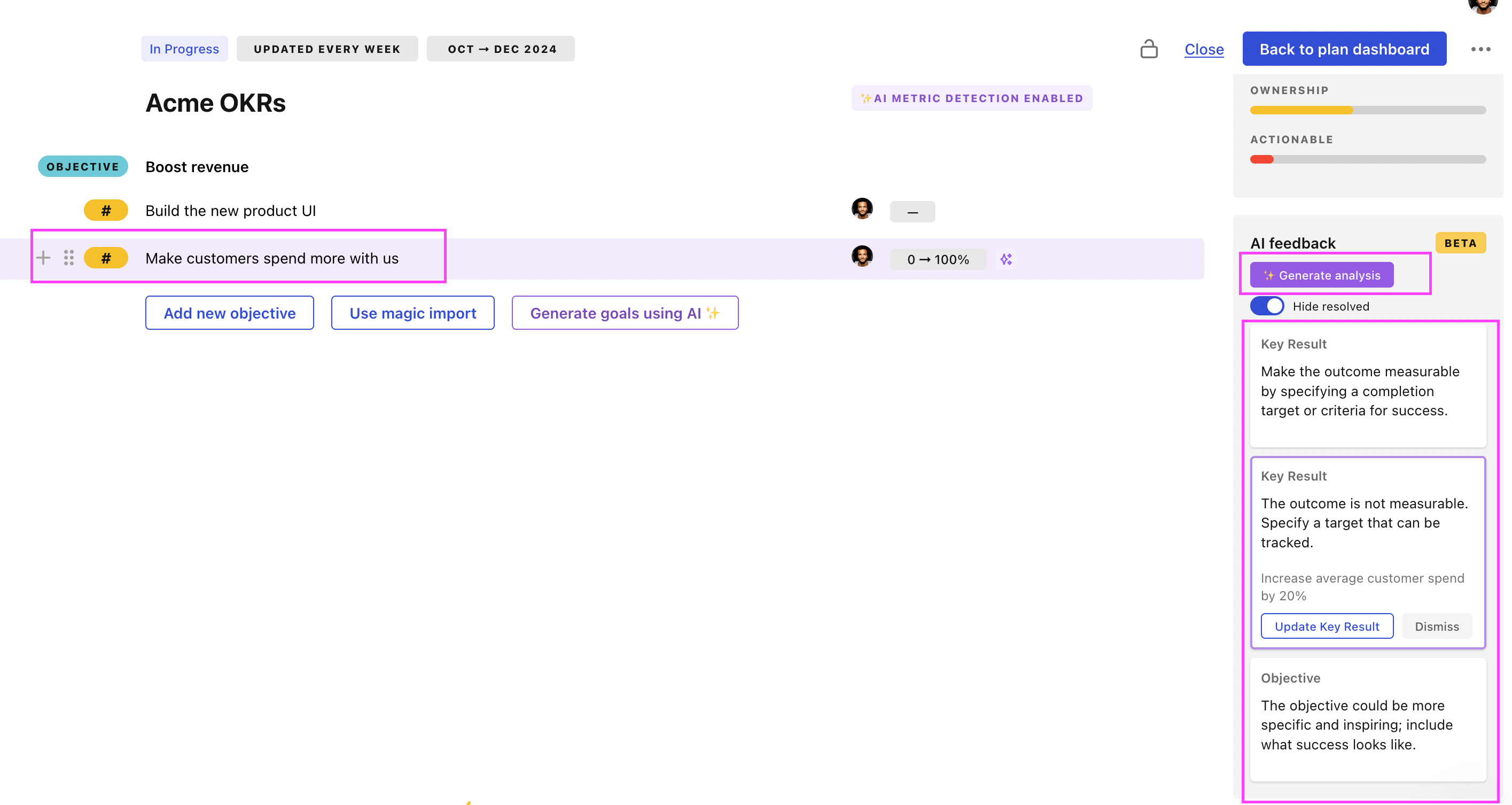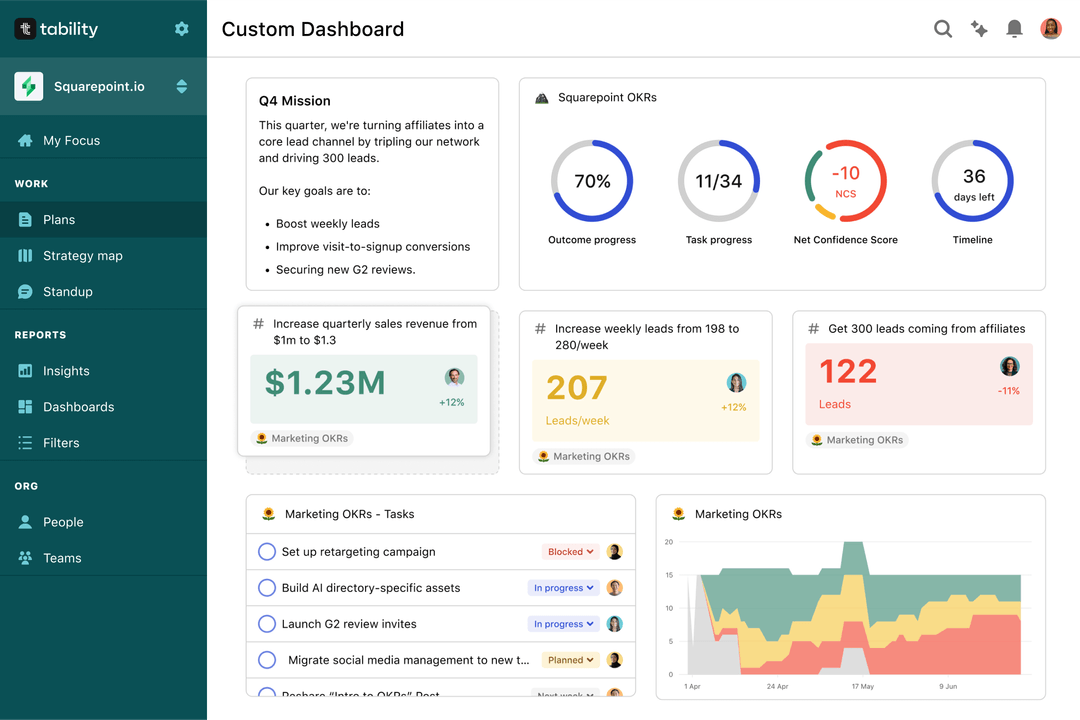Tability is a cheatcode for goal-driven teams. Set perfect OKRs with AI, stay focused on the work that matters.
What are Profitability Optimization OKRs?
The Objective and Key Results (OKR) framework is a simple goal-setting methodology that was introduced at Intel by Andy Grove in the 70s. It became popular after John Doerr introduced it to Google in the 90s, and it's now used by teams of all sizes to set and track ambitious goals at scale.
Creating impactful OKRs can be a daunting task, especially for newcomers. Shifting your focus from projects to outcomes is key to successful planning.
We've tailored a list of OKRs examples for Profitability Optimization to help you. You can look at any of the templates below to get some inspiration for your own goals.
If you want to learn more about the framework, you can read our OKR guide online.
The best tools for writing perfect Profitability Optimization OKRs
Here are 2 tools that can help you draft your OKRs in no time.
Tability AI: to generate OKRs based on a prompt
Tability AI allows you to describe your goals in a prompt, and generate a fully editable OKR template in seconds.
- 1. Create a Tability account
- 2. Click on the Generate goals using AI
- 3. Describe your goals in a prompt
- 4. Get your fully editable OKR template
- 5. Publish to start tracking progress and get automated OKR dashboards
Watch the video below to see it in action 👇
Tability Feedback: to improve existing OKRs
You can use Tability's AI feedback to improve your OKRs if you already have existing goals.
- 1. Create your Tability account
- 2. Add your existing OKRs (you can import them from a spreadsheet)
- 3. Click on Generate analysis
- 4. Review the suggestions and decide to accept or dismiss them
- 5. Publish to start tracking progress and get automated OKR dashboards

Tability will scan your OKRs and offer different suggestions to improve them. This can range from a small rewrite of a statement to make it clearer to a complete rewrite of the entire OKR.
Profitability Optimization OKRs examples
You'll find below a list of Objectives and Key Results templates for Profitability Optimization. We also included strategic projects for each template to make it easier to understand the difference between key results and projects.
Hope you'll find this helpful!
OKRs to build high-profit daytrading bots for NinjaTrader 8 using futures
ObjectiveBuild high-profit daytrading bots for NinjaTrader 8 using futures
KRIncrease the bot's profitability by 10% each quarter, without interruption
Implement upselling techniques in bot conversations
Enhance customer engagement to drive sales
Optimize bot operations to reduce cost and improve efficiency
KRAchieve a BOT success rate of 75% in simulation by month six
Conduct thorough simulation testing
Implement advanced bot learning algorithms
Refine bot responses based on test results
KRDesign a bot prototype and test for faults within the first three weeks
Sketch out initial bot design framework
Develop bot prototype based on sketch
Run rigorous tests to identify issues
OKRs to boost performance and profitability of meat industry retail store
ObjectiveBoost performance and profitability of meat industry retail store
KRIncrease monthly sales by 20% through optimizing inventory and marketing efforts
Review and streamline inventory management processes
Implement effective marketing strategies
Track progress and adjust strategies accordingly
KRReduce waste by 15% through implementing efficient storage and rotation system
Implement an efficient storage system
Initiate routine inventory rotation
Train staff on waste reduction practices
KRImprove customer satisfaction rate to 90% by enhancing customer service practices
Develop policies to efficiently handle customer complaints
Train staff in effective communication and customer handling techniques
Implement a customer feedback system to identify issues
Profitability Optimization OKR best practices
Generally speaking, your objectives should be ambitious yet achievable, and your key results should be measurable and time-bound (using the SMART framework can be helpful). It is also recommended to list strategic initiatives under your key results, as it'll help you avoid the common mistake of listing projects in your KRs.
Here are a couple of best practices extracted from our OKR implementation guide 👇
Tip #1: Limit the number of key results
Focus can only be achieve by limiting the number of competing priorities. It is crucial that you take the time to identify where you need to move the needle, and avoid adding business-as-usual activities to your OKRs.
We recommend having 3-4 objectives, and 3-4 key results per objective. A platform like Tability can run audits on your data to help you identify the plans that have too many goals.
Tip #2: Commit to weekly OKR check-ins
Having good goals is only half the effort. You'll get significant more value from your OKRs if you commit to a weekly check-in process.
Being able to see trends for your key results will also keep yourself honest.
Tip #3: No more than 2 yellow statuses in a row
Yes, this is another tip for goal-tracking instead of goal-setting (but you'll get plenty of OKR examples above). But, once you have your goals defined, it will be your ability to keep the right sense of urgency that will make the difference.
As a rule of thumb, it's best to avoid having more than 2 yellow/at risk statuses in a row.
Make a call on the 3rd update. You should be either back on track, or off track. This sounds harsh but it's the best way to signal risks early enough to fix things.
Save hours with automated Profitability Optimization OKR dashboards

The rules of OKRs are simple. Quarterly OKRs should be tracked weekly, and yearly OKRs should be tracked monthly. Reviewing progress periodically has several advantages:
- It brings the goals back to the top of the mind
- It will highlight poorly set OKRs
- It will surface execution risks
- It improves transparency and accountability
Spreadsheets are enough to get started. Then, once you need to scale you can use Tability to save time with automated OKR dashboards, data connectors, and actionable insights.
How to get Tability dashboards:
- 1. Create a Tability account
- 2. Use the importers to add your OKRs (works with any spreadsheet or doc)
- 3. Publish your OKR plan
That's it! Tability will instantly get access to 10+ dashboards to monitor progress, visualise trends, and identify risks early.
More Profitability Optimization OKR templates
We have more templates to help you draft your team goals and OKRs.
OKRs to implement SecOps playbooks for Abnormal security and Code42
OKRs to enhance quality in document management processes
OKRs to enhance the quality of client communication
OKRs to increase design competency and productivity for high-quality outputs
OKRs to enhance Direct-to-Consumer (DTC) conversion rates
OKRs to maximize financial growth and stability